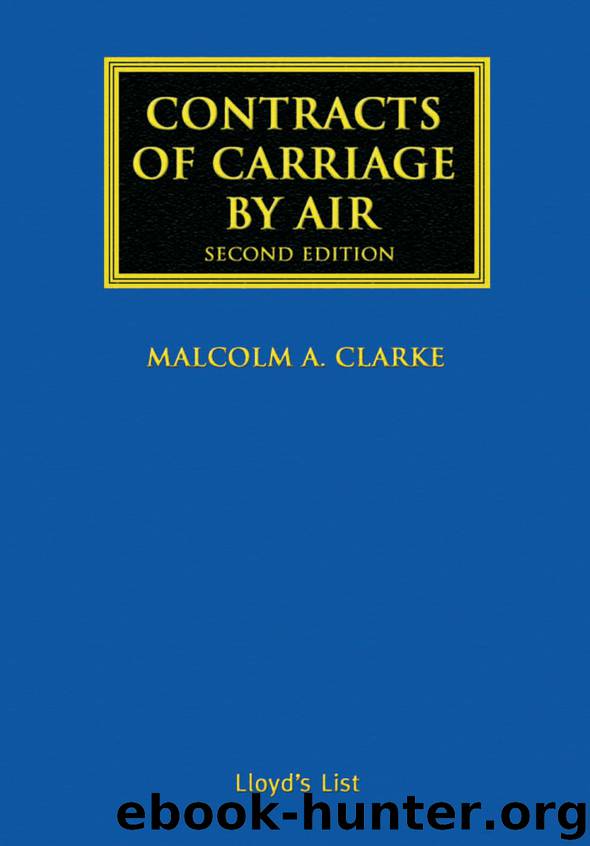Contracts of Carriage by Air

Author:Malcolm Clarke [Malcolm Clarke]
Language: eng
Format: epub
Publisher: Lloyd's List
Comment
According to a late draft of the 1929 text, this provision (then article 25) was to be triggered by an "intentional illegal act" (acte illicite intentionelle). However, in search of greater precision, the drafters adopted a British suggestion to replace that phrase with "wilful misconduct", a concept known to the common law but not to civil law systems. The text then provided that the carrier would be deprived of liability limits "if the damage is caused by his wilful misconduct or by such default on his part as [in accordance with the lex fori] is considered to be equivalent to wilful misconduct".823 However, the unintended effect in many civil law countries was to extend article 25 from acte illicite intentionelle to faute lourde.824 This was partly because the drafters’ intention was misunderstood and partly because wilful misconduct in the strict sense was so hard to prove that it did not serve its purpose, to deprive the carrier of liability limits in serious cases, often enough to satisfy courts.825
To restore the situation, the 1955 version of WSC replaced "wilful misconduct" with the current wording. The current wording of the rule underlines "the requirement of knowledge as to both intentional damage and recklessness",826 referring, as it does, to damage done with "intent to cause damage or recklessly and with knowledge that damage would probably result".827 The assumption, of course, is that a person knows that, where intending to cause damage, damage will probably result. As in 1929, something more than intent to cause damage was required, something akin to recklessness and the 1955 amendment was to spell out what was meant by that.828 Indeed, courts in the US have used the amended version to clarify the meaning of the original version, which remained in force there until 1999, and have thus in effect applied the amendment to cases in the US before 1999.829 The amendment embodies a subjective rule of a kind intended to make the liability limit harder to break than before830 but a rule nonetheless close to the intention of 1929.831
At the same time, the 1955 amendment doubled the normal liability limit, so that claimants would be less inclined to go to court because (a) they were satisfied with the level of compensation awarded and (b) courts would be less inclined to seek to break the limit and award more. This seems to have been largely achieved in the years after 1955 except in the US, where the higher 1955 limit was not considered high enough and was not adopted, and litigation on WSC article 25 continued to flourish.832 Litigation did not dry up entirely even in countries where the 1955 amendment was in force.
Whether the rule applies "must inevitably be determined by reference to the data of practical experience... Assessment of state of mind is essentially a factual inquiry."833 Assessment has proved difficult, a difficulty which can only be fully appreciated by seeing how courts have handled the factual inquiry. Hence the whole issue has been accurately described as a mixed question of law and fact,834 and reports of decisions are published.
Download
This site does not store any files on its server. We only index and link to content provided by other sites. Please contact the content providers to delete copyright contents if any and email us, we'll remove relevant links or contents immediately.
The Brazilian Economy since the Great Financial Crisis of 20072008 by Philip Arestis Carolina Troncoso Baltar & Daniela Magalhães Prates(117357)
International Integration of the Brazilian Economy by Elias C. Grivoyannis(87185)
The Art of Coaching by Elena Aguilar(52864)
Flexible Working by Dale Gemma;(23238)
How to Stop Living Paycheck to Paycheck by Avery Breyer(19613)
The Acquirer's Multiple: How the Billionaire Contrarians of Deep Value Beat the Market by Tobias Carlisle(12203)
Thinking, Fast and Slow by Kahneman Daniel(12004)
The Radium Girls by Kate Moore(11886)
The Art of Thinking Clearly by Rolf Dobelli(10162)
Hit Refresh by Satya Nadella(9009)
The Compound Effect by Darren Hardy(8756)
Tools of Titans by Timothy Ferriss(8176)
Atomic Habits: Tiny Changes, Remarkable Results by James Clear(8139)
Turbulence by E. J. Noyes(7913)
Change Your Questions, Change Your Life by Marilee Adams(7587)
A Court of Wings and Ruin by Sarah J. Maas(7585)
Nudge - Improving Decisions about Health, Wealth, and Happiness by Thaler Sunstein(7494)
How to Be a Bawse: A Guide to Conquering Life by Lilly Singh(7358)
Win Bigly by Scott Adams(7054)
